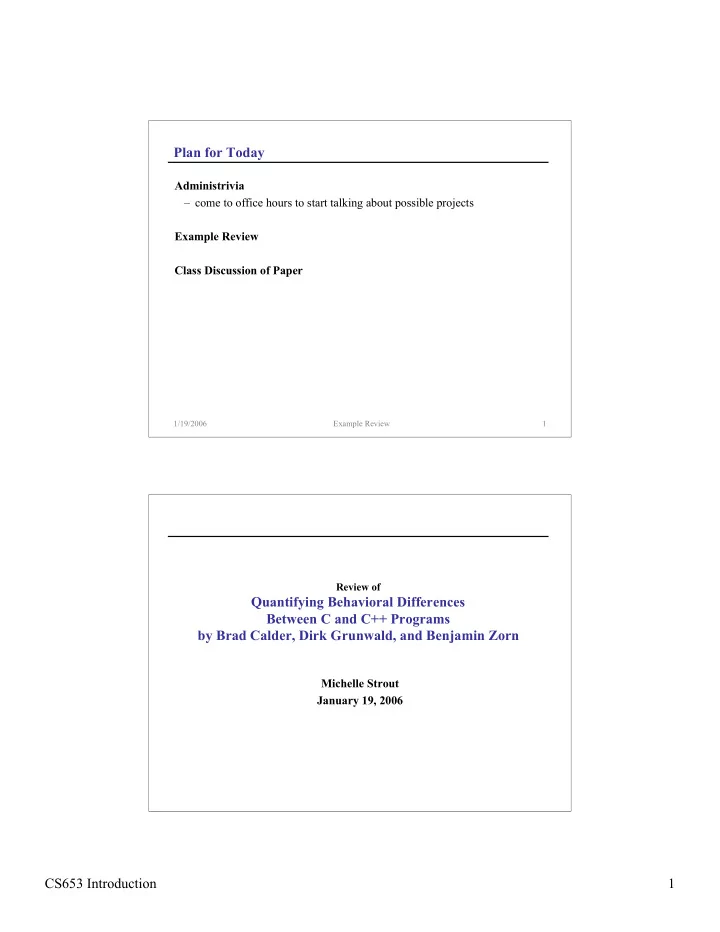

Plan for Today Administrivia – come to office hours to start talking about possible projects Example Review Class Discussion of Paper 1/19/2006 Example Review 1 Review of Quantifying Behavioral Differences Between C and C++ Programs by Brad Calder, Dirk Grunwald, and Benjamin Zorn Michelle Strout January 19, 2006 CS653 Introduction 1
What problem did the paper address? Big picture problem – How can we make C++ programs execute faster using hardware technology and compiler optimizations? Why problem is hard – C++ is a new language (1995) and perceived as different than previous languages – Computer architecture and optimizing compiler design has been driven by the behavior in C benchmarks Specific Problem – How do C++ programs behave in comparison to C programs? 1/19/2006 Example Review 3 Why should we care? In 1995 C++ was becoming the standard programming language in industry Similar program behavior studies in C and Fortran – guide computer architecture design – guide optimizing compiler design directly and indirectly through computer arch design No other study had compared the behavior between to closely related languages Benchmark selection – C programs from SPEC benchmarks, which are still used extensively in the computer architecture community: gcc, tex, etc. – C++ programs are academia and industry applications with many users 1/19/2006 Example Review 4 CS653 Introduction 2
What is the approach used to solve this problem? Empirical study of the behavior of C and C++ programs – hypothesis: “...C++ programs behave quite differently from C programs and that these differences may have a significant impact on performance” – select C and C++ benchmarks – that many people use – select some C++ benchmarks that have similar goals to C benchmarks – collect static and dynamic statistics about the program using the ATOM tool, execute programs on DEC Alpha architecture – also use cache simulation based on dynamic memory reference stats Static statistics – # of instructions, # of functions, #instrs/function, etc. Dynamic statistics – # of instructions, # func calls, # of indirect func calls, instrs per call, branching behavior, memory reference behavior, etc. 1/19/2006 Example Review 5 How does the paper support the conclusions it reaches? Some of their conclusions (most based directly on empirical results) – DHRYSTONE benchmark does not capture the behavior of C or C++ programs – C++ programs have “shorter procedures that are often reached via indirect function calls”, therefore need procedure inlining – C++ programs need different branch prediction architectures – C++ programs may have ILP problems – C++ program performance improves with a customized memory allocator – actually did a study to show this – link-time optimizations will be important 1/19/2006 Example Review 6 CS653 Introduction 3
Future Research Questions How do specific optimizations and reasonable optimization combinations affect performance differently in C and C++ programs? – constant propagation could help virtual method resolution – how many loops are parallelizable? What affect does alias/pointer analysis precision have on the program optimizations that are possible and their affect on performance? How much ILP is available in C++ programs? Similar to the Wall study. Is their a relationship between conditional branch directions and indirect function call targets? 1/19/2006 Example Review 7 Critique Hypothesis – have one, which is great – the hypothesis is weak and the experiments can only validate the first part “Truth in advertising” – points out in multiple places that the results rely heavily on the set of benchmarks – which compiler you use and which version of the operating system are important Empirical results – in each section they describe why the measurements they are taking are important Benchmarks – DHRYSTONE benchmarks were meant to model “average system behavior”, they don’t tell us what programs Weicker used to derive this – They say that input doesn’t have an effect. That is definitely not the case for performance in irregular applications, but they are studying #function calls, etc. 1/19/2006 Example Review 8 CS653 Introduction 4
Relation to CS653 Shows how to define a program performance problem – carefully select a set of benchmarks – collect statistics and calculate metrics about program behavior – determine how these statistics and metrics affect execution time – they used previous knowledge about this The next step – develop program optimizations (including the analyses that support them) to change those statistics and metrics in a way that improves execution time Related possible project – profiling benchmarks with Tau – redo the profiling after an optimizing compiler has “optimized” the benchmarks 1/19/2006 Example Review 9 Next Time Reading – Articles about program safety Class – Discussion of articles Due – Paper review for articles (if that is the review you are doing next week) 1/19/2006 Example Review 10 CS653 Introduction 5
Recommend
More recommend